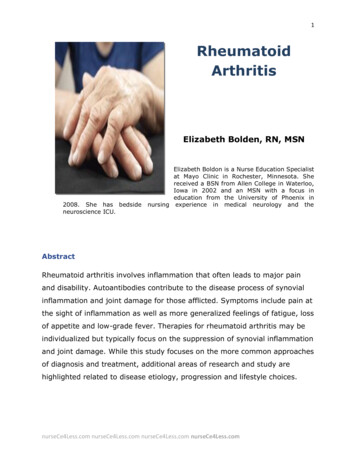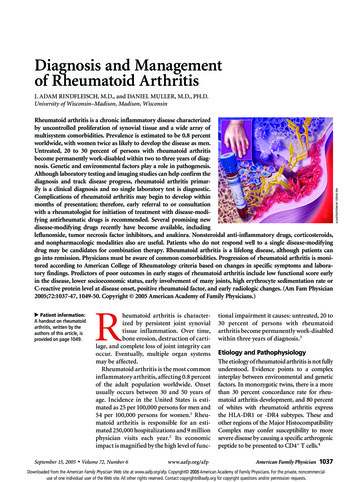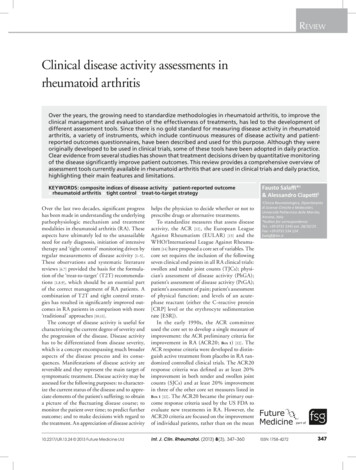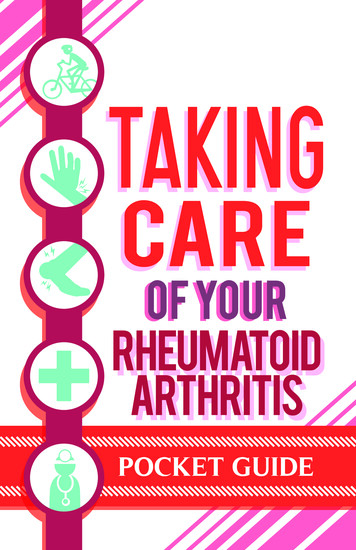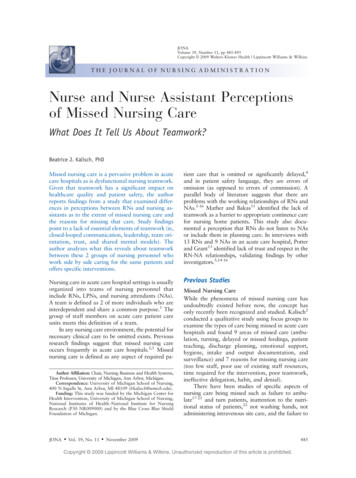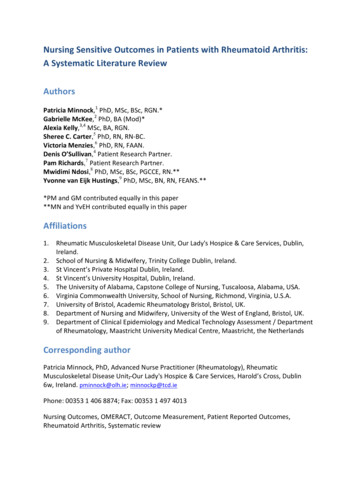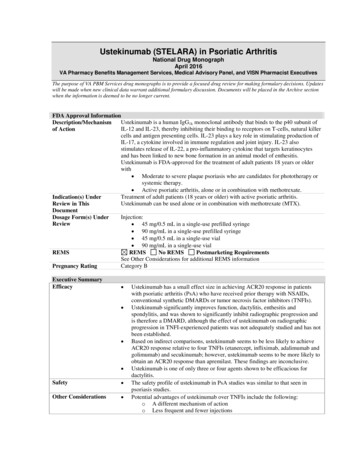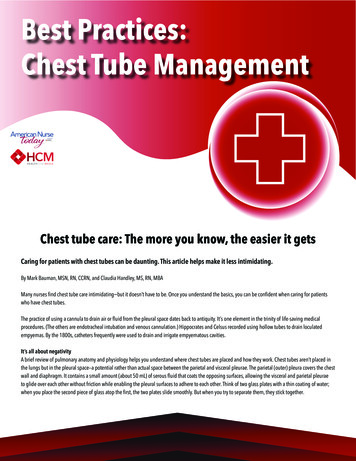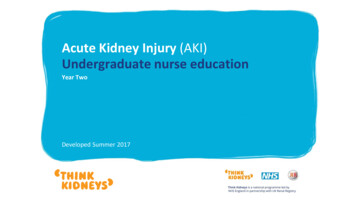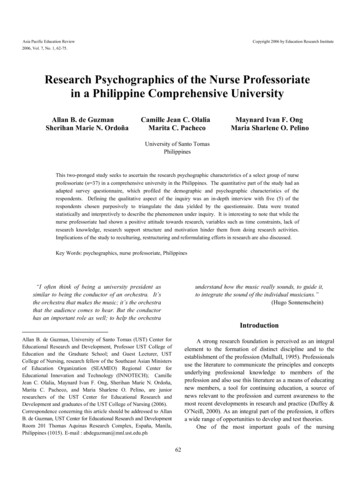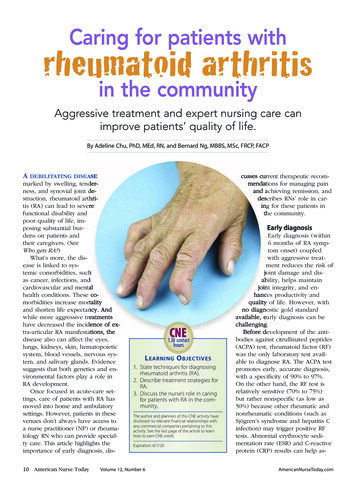
Transcription
Caring for patients withrheumatoid arthritisin the communityAggressive treatment and expert nursing care canimprove patients’ quality of life.By Adeline Chu, PhD, MEd, RN, and Bernard Ng, MBBS, MSc, FRCP, FACPA DEBILITATING DISEASEmarked by swelling, tenderness, and synovial joint destruction, rheumatoid arthritis (RA) can lead to severefunctional disability andpoor quality of life, imposing substantial burdens on patients andtheir caregivers. (SeeWho gets RA?)What’s more, the disease is linked to systemic comorbidities, suchas cancer, infections, andcardiovascular and mentalhealth conditions. These comorbidities increase mortalityand shorten life expectancy. Andwhile more aggressive treatmentshave decreased the incidence of extra-articular RA manifestations, thedisease also can affect the eyes,lungs, kidneys, skin, hematopoieticsystem, blood vessels, nervous system, and salivary glands. Evidencesuggests that both genetics and environmental factors play a role inRA development.Once focused in acute-care settings, care of patients with RA hasmoved into home and ambulatorysettings. However, patients in thesevenues don’t always have access toa nurse practitioner (NP) or rheumatology RN who can provide specialty care. This article highlights theimportance of early diagnosis, dis10American Nurse Todaycusses current therapeutic recommendations for managing painand achieving remission, anddescribes RNs’ role in caring for these patients inthe community.Early diagnosisCNE1.38 contacthoursL EARNING O BJECTIVES1. State techniques for diagnosingrheumatoid arthritis (RA).2. Describe treatment strategies forRA.3. Discuss the nurse’s role in caringfor patients with RA in the community.The author and planners of this CNE activity havedisclosed no relevant financial relationships withany commercial companies pertaining to thisactivity. See the last page of the article to learnhow to earn CNE credit.Expiration: 6/1/20Volume 12, Number 6Early diagnosis (within6 months of RA symptom onset) coupledwith aggressive treatment reduces the risk ofjoint damage and disability, helps maintainjoint integrity, and enhances productivity andquality of life. However, withno diagnostic gold standardavailable, early diagnosis can bechallenging.Before development of the antibodies against citrullinated peptides(ACPA) test, rheumatoid factor (RF)was the only laboratory test available to diagnose RA. The ACPA testpromotes early, accurate diagnosis,with a specificity of 90% to 97%.On the other hand, the RF test isrelatively sensitive (70% to 75%)but rather nonspecific (as low as50%) because other rheumatic andnonrheumatic conditions (such asSjögren’s syndrome and hepatitis Cinfection) may trigger positive RFtests. Abnormal erythrocyte sedimentation rate (ESR) and C-reactiveprotein (CRP) results can help asAmericanNurseToday.com
sess treatment response, but theseinflammatory markers aren’t usefulin diagnosing early-onset RA.Many clinical features of RA—joint deformities, rheumatoid nodules, and joint erosion on X-ray—don’t appear in early disease stages.However, pain and swelling in fingers and toes have high sensitivityfor RA (94.6%) early in the disease,but specificity of only 15.3%.Given the difficulty of accurateearly diagnosis, clinicians commonlyrely on a combination of a historyconsistent with inflammatory arthropathy (for example, morning stiffness lasting an hour or longer) andphysical findings of joint swelling inclassic RA patterns (symmetrical involvement of small joints). RA diagnosis may be made even without apositive RF/ACPA test.Who gets RA? 1.5 million U.S. adults have been diagnosed with rheumatoid arthritis (RA),according to a study published in 2008. 41 of every 100,000 people in the United States are diagnosed with RA annually. Incidence rises with age, peaking between ages 65 and 74.RA affects both men and women ages 18 and older, but more women thanmen are diagnosed with the disease.Early aggressive treatmentBefore 1980, the pyramid approachto RA treatment started with aspirinor other nonsteroidal anti-inflammatory drugs. Disease-modifying antirheumatic drugs (DMARDs), suchas methotrexate, were reserved forpatients with severe disease orthose who didn’t respond to conservative treatment. Reluctance toprescribe DMARDs stemmed fromlack of knowledge about early aggressive treatment to minimize permanent joint damage, unfamiliaritywith optimal dosing, and few effective drugs with high benefit-to-riskratios. As a result, many patientsbecame disabled 10 to 20 years after diagnosis due to severe joint deformities and extra-articular manifestations.Current RA treatment recommendations focus on early aggressive therapy. For example, clinicians should initiate DMARDs(preferably methotrexate) immediately after diagnosis, with the goalof achieving remission or low disease activity. Patients who don’trespond to traditional DMARDmonotherapy may be candidatesfor combination therapy, such asAmericanNurseToday.comNormalmultiple traditional DMARDs orconcomitant biologic agents, suchas tumor necrosis factor inhibitors(TNFis); examples of TNFis includeetanercept, infliximab, and adalimumab. The current treatmentmodel has dramatically reduced severe joint deformities and extra-articular manifestations.Patients receiving these agentsrequire close monitoring foradverse effects. For example,methotrexate is associated withhepatotoxicity and bone marrowsuppression, so patients takingthis drug should undergo complete blood counts and liver enzyme tests every 2 to 3 months.And because of the immunomodulating actions of biologics that increase the risk of certain infections, patients taking TNFis andother biologic agents should betested for latent tuberculosis andreceive pneumococcal, zoster, andinfluenza vaccinations before be-Rheumatoid arthritisginning treatment. (See Recommended drug therapies for RA.)Multidisciplinary approachPatients with extensive joint damage need ongoing treatment andclose monitoring, along with instructions to adhere to prescribeddrug therapy. These actions arebest coordinated through a multidisciplinary approach. Dependingon the individual patient’s needs,the team may include a rheumatologist, rheumatology NP, RN, pharmacist, physical therapist, occupational therapist, podiatrist, physicianassistant, and social worker. Tohelp ensure optimal physical andpsychosocial functioning and quality of life, the team provides education and support based on the patient’s goals.Some multidisciplinary modelsinclude specialized arthritis programs, ongoing management, triage,rural consultant support, and teleJune 2017American Nurse Today11
Recommended drug therapies for RAThis chart summarizes recommended drug therapies for the aggressive treatment of rheumatoid arthritis (RA).Commonly used disease-modifying antirheumatic drugs (DMARDs) and biologic agentsDrug nameRouteOptimal dosageAdverse effectsMonitoringSynthetic DMARDsMethotrexate*OralSubQ15-30 mg/week HepatoxicityBone marrow suppressionNauseaOral ulcersHair lossTeratogenic effectsHydroxychloroquine*Oral200-400 mg daily Retinal toxicity Annual eye examinationsSulfasalazine*Oral1-1.5 g twice daily Nephritis Azoospermia Bone marrow suppression Blood counts, liver enzymeslevel every 2-3 monthsLeflunomideOral20 mg daily Blood counts, liver enzymes,creatinine level every 2-3monthsHepatoxicityBone marrow suppressionNauseaOral ulcersHair loss Initial screen forhepatitis B and C Blood counts, liver enzymes,creatinine levelevery 2-3 monthsBiologic agentsTumor necrosis factorinhibitors (TNFis)**SubQIVVaries Reactivation of TB, infections Initial screen for TB andhepatitis B and C Ensure vaccinations are upto-dateAbataceptSubQIVSubQ: 125 mg/weekIV: 500-1,000 mg(weight based); initialdose is repeated 2-4weeks later, then every4 weeks InfectionsHeadacheNauseaCOPD exacerbation Initial screen for TB,hepatitis B and C Ensure vaccinations areup-to-dateTocilizumabSubQIVSubQ: 162 mg/week orevery other weekIV: 4-8 mg/kg every4 weeks Upper respiratory infectionHeadachesHypertensionIncreased ALT Initial screen for TB, hepatitisB and C, neutrophil count 2,000/mm3, platelet count 100,000/mm3, AST and ALTnot more than 1.5 timesupper limit of normalRituximabIV1,000 mg at week 0and week 2, then every6 months Respiratory infectionsHeadacheMuscle spasmsPeripheral edemaHepatitis B reactivationProgressive multifocalleukoencephalopathy Initial screen for TB, hepatitisB and C Ensure vaccinations areup-to-dateALT alanine transaminase, AST aspartate aminotransferase, COPD chronic obstructive pulmonary disease, subQ subcutaneous, TB tuberculosis*Methotrexate, hydroxychloroquine, and sulfasalazine may be used in combination (triple therapy).**Five TNFis are currently approved for use in RA: adalimumab, certolizumab pegol, etanercept, golimumab, and infliximab.12American Nurse TodayVolume 12, Number 6AmericanNurseToday.com
medicine. Given the lack of reimbursement for hospitalization, mostmultidisciplinary programs are conducted in outpatient and communitysettings as day-patient programs. Inthe United States and across Europe,nurses have become an integral partof the multidisciplinary team, engaging in tasks traditionally performedonly by rheumatologists. (See NPs’impact on RA care.)Providing care in the communityWith limited availability of rheumatology NPs and rheumatology RNs inhome health care, some long-termcare facilities, hospices, schools, andfaith-based organizations employRNs to manage and coordinate theplan of care established by therheumatologist or NP.So RNs must be knowledgeableabout RA pathophysiology, treatment, and management. We’ll usethe nursing process steps of assessment, diagnosis, planning, implementation, and evaluation as aguide for managing patients and, asapplicable, their caregivers.Conduct an initial assessmentDuring your initial assessment ofthe patient and caregiver, establishgoals and expected outcomes forsuccessful disease management.Many patients with RA experienceanxiety, anger, frustration, and depression. When you recognizethese emotions, encourage the patient to discuss them with therheumatologist or NP.Key nursing actions at this stageare to establish a therapeutic relationship with the patient and caregiver, assess their understanding ofRA and its management, and evaluate their physical, emotional, andpsychological well-being.Identify appropriate nursingdiagnosesRA signs and symptoms vary withdisease severity. Note joint swellingand pain, morning stiffness, and deformities. Pain and deformities mayAmericanNurseToday.comNPs’ impact on RA careNurse practitioners (NPs) who specialize inrheumatology work in such settings as rheumatology clinics, hospitals, and medical homes. They assess, diagnose, and conduct follow-up with patients, administer intra-articular joint injections,recommend and prescribe therapeutic agents,and coordinate care in both inpatient and outpatient settings.Recent studies report that NP-led clinics produce similar or better outcomes in RA patients’physical function, disease activity, pain, and quality of life, compared with RA patients seen only byrheumatologists.In 2013, ANA published Rheumatology Nursing:Scope and Standards of Practice, a vital referencefor NPs and other nurses in this specialty.limit the patient’s ability to performactivities of daily living (ADLs),which may lead to frustration, lowself-esteem, and poor quality of life.Evaluate family dynamics as well asethnic and cultural influences onthe patient’s perception of RA andself-care abilities.Use the information you’ve gathered to identify appropriate nursingdiagnoses. Common ones for patients with RA are pain and discomfort, activity intolerance and impaired mobility, self-care deficits,fall risk, ineffective coping, alteredbody image or role performance,ineffective health maintenance,nonadherence to the therapeuticregimen, and caregiver role strain.Collaborate in care planningWork with the patient and caregiver to set measurable short- andlong-term goals to achieve expected outcomes based on the nursingdiagnoses. Evaluate their readinessto learn and motivation to participate in care. As you do this, besure to: reinforce the multidisciplinaryteam approach to care discuss psychological factors related to RA, such as depression,anxiety, and stress explain drugs used to treat RA discuss nonpharmacologic approaches, such as joint protec-tion, heat and cold therapy,range-of-motion exercises, andcomplementary and alternativetherapies, as prescribed by theprovider.To enhance your effectiveness,ask open-ended questions, be sensitive to cultural preferences andfamily communication styles, andavoid arguing with the patient orcaregiver.Implement the planAfter devising a plan of care, implement evidence-based strategiesbased on established priorities, andprovide patient education. Explainto the patient and caregiver that RAis a progressive chronic systemicdisease that eventually may affectADLs. Discuss the importance ofadhering to prescribed drug therapyand nonpharmacologic treatment tocontrol pain. Because of the remitting and relapsing nature of RA, review signs and symptoms of flareswith the patient and caregiver.Use the following strategies toenhance your effectiveness: Identify the preferred teachingmethod for and learning styles ofthe patient and caregiver. Educate them about the prescribed drug regimen to controlpain and achieve remission. Reinforce the importance ofJune 2017American Nurse Today13
Online resources for patients with RAThe websites listed below, run by the U.S. government (.gov) and nonprofit organizations (.org), provide trusted, accurate information on rheumatoid arthritis(RA). But you should still evaluate the information sources for each website beforeusing them to teach patients and their caregivers.American College of Rheumatology (ACR)The ACR provides consumer health information and short videos on rheumaticdiseases, discusses
rheumatoid arthritis in the community Aggressive treatment and expert nursing care can improve patients’ quality of life. By Adeline Chu, PhD, MEd, RN, and Bernard Ng, MBBS, MSc, FRCP, FACP LEARNING OBJECTIVES 1. State techniques for diagnosing rheumatoid arthritis (RA). 2. Describe treatment strategies for RA. 3. Discuss the nurse’s role in caring
